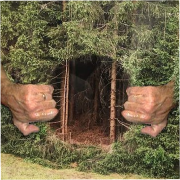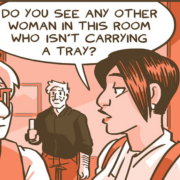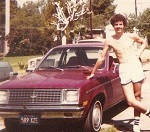- Adbot
-
ADBOT LOVES YOU
|

|
|
#
?
May 30, 2024 21:30
|
|
- EvenWorseOpinions
- Jun 10, 2017
-

|
Speaking of being stupid and not turning the power off, in high school a friend and his dad and I would all go out on weekend trips to restore my friend's dad's dad's house so it could get sold, friend's dad's dad in question managed a power plant in the 70s until his retirement so HE WAS AN ELECTRICITY EXPERT, and did his own wiring on his house. We were replacing the ancient outlets through the house and were in the ground floor living room with friend's dad at the breaker in the basement below, communicating through the black mold hole in the bathroom floor, and he called bedroom breaker open, basement breaker open, living room breaker open, so we pulled the cover off and stuck a screwdriver in the outlet, immediately shorted the exposed wires to the outlet case, threw sparks and smoke everywhere, and flipped the attic breaker open. I wish I knew what a multimeter was back then
EvenWorseOpinions fucked around with this message at 18:08 on Jan 15, 2020
|
 #
?
Jan 15, 2020 17:18
#
?
Jan 15, 2020 17:18
|
|
- terrenblade
- Oct 29, 2012
-

|
Haha. I didn't see the tracks so I was watching that thinking "Why are there parking lot gates in the middle of this road?"
And then the train appeared.
Driver didn't see the tracks either.
I find it cathartic how the train missed the heavy equipment and still managed to disable the transport so it couldn't flee the scene.
|
 #
?
Jan 15, 2020 18:30
#
?
Jan 15, 2020 18:30
|
|
- PHIZ KALIFA
- Dec 21, 2011
-

#mood
|
this is some Profoundly satisfying trucklefuckening.
|
 #
?
Jan 15, 2020 18:51
#
?
Jan 15, 2020 18:51
|
|
- PurpleXVI
- Oct 30, 2011
-

Spewing insults, pissing off all your neighbors, betraying your allies, backing out of treaties and accords, and generally screwing over the global environment?
ALL PART OF MY BRILLIANT STRATEGY!

|
Speaking of being stupid and not turning the power off, in high school a friend and his dad and I would all go out on weekend trips to restore my friend's dad's dad's house so it could get sold, friend's dad's dad in question managed a power plant in the 70s until his retirement so HE WAS AN ELECTRICITY EXPERT, and did his own wiring on his house. We were replacing the ancient outlets through the house and were in the ground floor living room with friend's dad at the breaker in the basement below, communicating through the black mold hole in the bathroom floor, and he called bedroom breaker open, basement breaker open, living room breaker open, so we pulled the cover off and stuck a screwdriver in the outlet, immediately shorted the exposed wires to the outlet case, threw sparks and smoke everywhere, and flipped the attic breaker open. I wish I knew what a multimeter was back then
I feel like there absolutely have to be more stories about this place.
|
 #
?
Jan 15, 2020 18:54
#
?
Jan 15, 2020 18:54
|
|
- Bacon Taco
- Jun 8, 2006
-

Now with extra narwhal meat!
HAIKOOLIGAN
-
Dinosaur Gum
|
Reminds me of my childhood in rural Tennessee when my dad had to pull off the lovely wooden paneling in some room on occasion in order to use a propane torch to heat and unfreeze the pipes. At least he had my mom stand over him with a fire extinguisher just in case.
|
 #
?
Jan 15, 2020 19:20
#
?
Jan 15, 2020 19:20
|
|
- EvenWorseOpinions
- Jun 10, 2017
-

|
I feel like there absolutely have to be more stories about this place.
There are more stories, but that's probably the best one, and the only one that is both OSHA and entertaining. All the others are things like finding mouse skeletons packed into a section of wall or showing up to find the partially insane neighbor rummaging through the garage trying to retrieve the deer camera that he had specifically been told he wasn't allowed to put up on the property.
E: I forgot one actually, friend's dad's dad was a powerplant manager as mentioned, in the olden days you just put coal ash wherever you felt like, so when the plant's ash pits got full he as the manager paid himself to dump coal ash on his personal land. He didn't make a pit or anything, just dumped it out on a field of his. I don't remember specifics but the elevated levels of heavy metals had some sort of ramifications for selling the land and probably other things.
EvenWorseOpinions fucked around with this message at 21:11 on Jan 15, 2020
|
 #
?
Jan 15, 2020 19:26
#
?
Jan 15, 2020 19:26
|
|
- Cojawfee
- May 31, 2006
-
I think the US is dumb for not using Celsius
|
Why does it look like the train is tilting over? is that just an effect of the camera shutter?
|
 #
?
Jan 15, 2020 19:50
#
?
Jan 15, 2020 19:50
|
|
- ncumbered_by_idgits
- Sep 20, 2008
-

|
Why does it look like the train is tilting over? is that just an effect of the camera shutter?
I think it's that the rail cars have angled sides.
|
 #
?
Jan 15, 2020 20:03
#
?
Jan 15, 2020 20:03
|
|
- Sagebrush
- Feb 26, 2012
-


|
Yep it's called a rolling shutter artifact. In this case, you can tell that the CCD reads out from the top to the bottom, line by line; by the time the frame is done capturing the train has moved forwards, so the bottom slides a little bit in front of the top, and it looks like it's leaning backwards. Most cheap image sensors, like you'd have in a security camera or cell phone, do this. More expensive sensors like those in a digital SLR tend to read the whole frame at once to eliminate that artifact.
Fun fact: this effect is why animators distort cars' wheels into ellipses, and generally lean the whole car forwards, as a visual shorthand for "going fast."

Obviously cars don't look like that in real life no matter how fast they're going. But if you're a photojournalist in the 1930s, and you have a camera with a travelling-slit shutter, then you get the exact same effect. The film is exposed over a brief period of time -- from the bottom up, due to the curtain design of most camera shutters at the time, rather than top-down like most modern image sensors -- so the bottom parts of the scene are recorded first, and fast-moving objects look like they're leaning forwards. Animators looking at photographic/filmed references of fast cars picked up on the effect and now it's just part of our shared visual language.


Sagebrush fucked around with this message at 20:24 on Jan 15, 2020
|
 #
?
Jan 15, 2020 20:22
#
?
Jan 15, 2020 20:22
|
|
- goatsestretchgoals
- Jun 4, 2011
-

|
Speaking of trains eating things, check out this near miss when the barriers at a level crossing went up too early. The new trains on this line are having trouble activating the track circuit that tells the level crossing where it is, you can see the crossing lights turn yellow to red then back to yellow because it thinks the train's gone past.
https://www.youtube.com/watch?v=zhlk6JxwEkQ
The train went hungry that evening. The humble cars and vans live another day.
What the holy gently caress? Why were trains running down that line if the crossing gates were hosed up?
E: The drivers were also dumb for driving across the tracks when (I assume because video had no sound) the train was using its 100 million decibel HOLY gently caress OFF horn. The only person who wasn't dumb in this video was the poor engineer. I hope the railroad bought him some new pants.
goatsestretchgoals fucked around with this message at 20:29 on Jan 15, 2020
|
 #
?
Jan 15, 2020 20:25
#
?
Jan 15, 2020 20:25
|
|
- snugglz
- Nov 12, 2004
-
moist sod for your hogan
|
https://i.imgur.com/gcWEARg.mp4
|
 #
?
Jan 15, 2020 20:52
#
?
Jan 15, 2020 20:52
|
|
- goatsestretchgoals
- Jun 4, 2011
-

|
Okay, that makes more sense in a horrible way.
Wasn't there a goon who effort-posted detailed breakdowns of other UK rail fuckups? I think it was in the last OSHA thread and I'm looking, but I'm really lighting the train signal for that person to talk about this.
E: Well I didn't expect that to work, got it in one site:forums.somethingawful.com search on Google:
https://forums.somethingawful.com/showthread.php?threadid=3763899&userid=106859
goatsestretchgoals fucked around with this message at 22:15 on Jan 15, 2020
|
 #
?
Jan 15, 2020 22:12
#
?
Jan 15, 2020 22:12
|
|
- PHIZ KALIFA
- Dec 21, 2011
-

#mood
|
Okay, that makes more sense in a horrible way.
Wasn't there a goon who effort-posted detailed breakdowns of other UK rail fuckups? I think it was in the last OSHA thread and I'm looking, but I'm really lighting the train signal for that person to talk about this.
E: Well I didn't expect that to work, got it in one site:forums.somethingawful.com search on Google:
https://forums.somethingawful.com/showthread.php?threadid=3763899&userid=106859
those were posted in the last thread and i thiiiiiiiiiiiiiiiiiiiiiiiiiink some have been quoted in the early pages of this thread.
|
 #
?
Jan 15, 2020 22:15
#
?
Jan 15, 2020 22:15
|
|
- goatsestretchgoals
- Jun 4, 2011
-

|
Gonna quote the Clapham Junction posts for all those who don't have archives because this poo poo seems relevant:
It seemed well received so Iíll have a look at explaining Clapham Junction now. This one is a biggy so I think Iíll split it up. To really get the gist of what went wrong its worth going into a bit of detail about the basics of how signalling works.
The safety of UK railways is founded almost entirely on track circuit block and distance interval working. The basic principles of that are sound and allow trains to travel at high speeds extremely closely to each other with pretty much no prospect of any accident. At Clapham the basic principles of track circuit block went badly wrong.
When the railway was new safety was governed by time interval working, i.e. only a period of time separated trains. A train went along the track, a period of time was measured, then another train went along the track, and so on. You can see the problem. There was no method of any kind to communicate with the trains. So no one knew what had happened to that first train. It could have reached its destination hours ago and still no one knew. Or everyone involved could have been killed and no one knew. The time was measured, and the next train was sent.
If that sounds like an incredibly dangerous way of working thatís because it was. But donít worry Ė you were much more likely to be killed by the basic technical problems on the engines themselves causing massive explosions than by them ever crashing into each other. So thatís nice.
Distance interval working was considerably safer. A measure of distance rather than time was used to separate trains. The train was sent, you waited until confirmation it had reached the next station, then the next train went. This required communication. Eventually it developed into signallers and signal boxes. Each signal box was responsible for one bit of track. They observed the train arrive and told the previous signal box it was there safely, and therefore crucially had vacated the track between the boxes. Then they asked the next signal box for permission to let the train proceed and if they received confirmation the track ahead was clear, they sent the train on its way.
This, incidentally, is why trains have red lights on the rear. Only by observing the red lights did the signaller know the whole train had arrived and that no divided coaches had been left in the section.
So we had distance interval working and absolute block sections Ė the railway was divided into sections and if a train was still in a section the next train wasnít allowed to enter. The next step was track circuit block, which we still use for the most part. This involves an electrical current running through the tracks and connected to the signal Ė a track circuit. If that circuit has power the green light on the associated signal was lit and trains could enter that section of track. If that circuit lost power, i.e. because train wheels on the track shorted it out, the red signal was lit and trains were therefore told they had no permission to enter that section because it was still occupied. That means every train would be automatically protected in the rear by a red light by very straightforward electrical circuits. In theory.
The only thing to then be added was cautionary aspects where necessary. If a signal was red the signal ahead automatically turned to single yellow, which warned the driver to begin braking. If you have four aspect signalling the signal ahead of the single yellow displayed two yellows Ė prelimary caution. This means drivers no longer have to be able to react and stop in only a sightlines distance, they can reduce their speed miles before needing to stop because they have been warned of the approaching red signal several signals beforehand. This allows trains to run closer together at higher speeds.
That is no doubt not entirely accurate as a historical picture. But it gives the rough direction of how and why things have developed in the way they have.
On Monday 12th December 1988 several drivers on the northbound approach to Clapham Junction say signal WF138 changed as they approached it. This isnít unusual in itself. If the train ahead is moving forward you would expect track circuits to become clear as the train moves, causing signals to go from red to yellow, etc. However many of them saw it go from green to double yellow, or double to single yellow. None reported it. There were plausible explanations in their minds for every change, for instance the signaller could have routed a train ahead of them somewhere. The rule book at the time was very vague and only said they had to report irregularities that could be a danger to another train. As they all had reasonable stories in their heads for the change the prospect of danger to trains wasnít obvious.
However eventually Driver McClymont on the train from Basingstoke witnessed signal WF138 turn from single yellow to red in front of them. They were unable to stop and went past it. This was a signal passed at danger, even if it wasnít his fault, so he had to report it immediately. He stopped the train at the next signal, WF47 Ė the last signal before Clapham Junction station, to use the Signal Post Telephone and report it to Signaller Cotter at the Clapham Junction signal box. WF138 then changed back to single yellow, despite the presence of the Basingstoke train on the track circuit controlling it.
Driver John Rolls on the service from Poole was driving normally to the signals he saw and approaching Clapham Junction at about 60mph. There was no data recorder on the train but an off duty driver was sitting in the back cab, which also has a live brake gauge and speedometer. The off duty driver saw the brake gauge go into emergency for a few seconds, and estimated the speed was about 35mph when the Poole train hit the Basingstoke train in a rear end collision.
Driver Rolls was killed along with 32 of the passengers sitting in the front three coaches. 69 people were seriously injured, two of whom later died from their injuries. 415 people suffered minor injuries. The first coach was subject to what the later report described as ďcomplete disintegrationĒ, and the following two coaches derailed. To make matters worse a set of empty coaching stock coming from Clapham on the adjacent line then struck the wreckage and also derailed. Itís not clear if this directly killed or injured anyone, but it definitely didnít help.
Driver Pike on the train following Driver Rolls saw the wreckage ahead a few minutes later and applied the emergency brakes. He estimated he stopped 20 metres from the crash but it was later measured as more like 60. He walked back to signal WF138, which he had passed at proceed, and saw it was still displaying a single yellow, despite the presence now of three trains in total on the track circuit controlling it. He reported this to Signaller Cotter quite forcefully.
The signal box was examined later that day and it was found that the electrical relay for the track circuit for signal WF138 had an extraneous section of wire. This had intermittently connected current to the circuit when it should have been shorted, so it was still able to show proceed aspects despite the track circuit being occupied. Post two on how that wire came to be there.
Part 2 on Clapham Junction:
The wiring on the relays had been put in by a signalling technician called Brian Hemingway two weeks before the crash. This was part of the Waterloo Area Resignalling Scheme (WARS), which had been planned and implemented from 1978 onwards. Waterloo is the busiest London rail terminal, as anyone who has watched the opening scenes of The Bourne Ultimatum knows (itís the place where Paddy Considine gets shot). Clapham Junction is a major station on approach to Waterloo where the lines from Windsor, Wessex, and Sussex all join. It still proudly boasts it has the largest number of passenger interchanges per day in the whole of Europe.
The signalling for this whole area hadnít been renovated since 1936. By 1978 the situation was bad. By 1988 it was desperate. So WARS was being implemented rapidly. This involved replacing and re-numbering a large number of signals, including WA25 which was to become WF138. This was done by Brian Hemingway on Saturday 27th November 1988. He put in the new wires but did not take out one of the old ones. He just cut it at one end Ė still attached at the other. He did not put insulating tape around the loose end, he just pushed it out of the way of the circuit.
This was surprisingly not a problem until two weeks later on, Sunday 11th December, when a wiring job was required, again as part of WARS, on the relay next to this one in the relay room. This disturbed the WF138 wire and allowed it to contact the circuit at its un-insulated end again. By chance the person conducting this work was Brian Hemingway again. On the following Monday morning, when the line was reopened, the signal displayed green or red entirely independently of what the track circuit was doing and instead dependent on whether the wire was making contact in the relay. For the early morning the train service was infrequent and even though the aspects were wrong there was sufficient space between trains that no crash was possible. When rush hour started the trains bunched up and it was only a matter of time before a proceed was shown when a train was physically stopped on that circuit. So the accident happened shortly after 8am. For this very reason the trains were also carrying more people. Over 1500 passengers were on Driver Rollsí train from Poole.
Why did Brian Hemingway do the wiring job this badly? Some of the mistakes were ones it was later found he always made. Some were ones he made only the day and couldnít account for.
He was asked why he hadnít removed the old wire. His answer was he never did that. Not only that, no one who did the same job did that either, so far as he knew. He had never been trained to do that. He had never been questioned by an assessor or supervisor for not doing that. The importance of doing so was not clear to signalling technicians across the board. Anyone could have been doing that job on 27th November and made the same mistake, which is why the inquiry did not find him at fault despite that in his evidence he claimed full responsibility.
His training had been on the job. Heíd been working for British Rail for years. Whilst new signalling technicians had a training course when they joined the older ones had not been put on it. Following a series of signal irregularities a few years before an instruction had gone out from BR Standards head office that all signalling jobs must include a count of wires left to ensure all the old ones had been removed. No one could demonstrate that Hemingway would ever have seen this. Even senior managers responsible for WARS werenít aware this was an instruction. They thought it was a consultation paper, and did not distribute it to staff. In fact, as they thought it was a consulation paper they wrote back their disagreement with it and left it at that. No one from Standards followed it up.
Then there is the issue of his supervision. His supervisor on the day was Derek Bumstead, and the testing engineer was Peter Dray. Derek Bumstead turned out to be supervising in name only as he wasnít present. Signalling and Telecomms (S&T) were short staffed so he was actually at another site working with a gang on the tracks. That was his style of management. He liked to muck in and help. Neither Hemingway or Bumstead had any expectation that Bumstead would check the work in the relay room. Peter Dray was responsible on paper for conducting testing for this area, but as WARS was a special project it wasnít clear to him he was responsible for that work as well. A number of management reorganisations over the years had left it very unclear who was conducting quality assurance for what. It was inevitable stuff would get missed eventually.
So we come to the peculiar errors, like the lack of insulating tape. Hemingway reported he always used tape and had no idea why he hadnít in this case. Remember I said he did the work on both Sunday 11th December and Saturday 27th November? Well in fact he had worked every day in between. Not only that, he had worked all but one day in the preceding three months. Out of 91 days he had worked 90 of them. A survey of technicians in his grade demonstrated that nearly a third had in fact worked every day over that period, and another third took one day off on average every two weeks. The pay wasnít great so there was a large number of people who would do every hour of overtime they could.
This was in fact common across most grades. My uncle was a signaller in the 1980s and he tells stories now of regularly working nightshifts and getting a call towards the end of it asking if he could come back to cover a late shift just a few hours later. So he would go home, take my cousins to school, sleep for 2 or 3 hours, then go back to work in the signal box. One of the driving instructors I learnt with had been a driver for nearly 40 years. In the 1980s he said he would quite commonly not go home for 2-3 days at a time. He would drive trains, then sleep on a sofa in the messroom for a few hours, then drive trains again. There was no point even leaving the depot.
Local management were asked why they were running their staff into the ground like this. The answer was they were running out of time to get WARS done. It had been on the cards since 1978 but the planning for the actual wiring work for this stage of it wasnít done until 1986. But even this meant the plan for what work would be done on what days was drawn up two years before the work happened. In that time staff levels changed, so to keep up they just offered more and more overtime to those who were left. Senior British Rail managers expressed shock and dismay, as all senior managers do in these circumstances, that those on the rung down could possibly have thought the project completion date was such an immovable deadline. I cannot roll my eyes hard enough at that. The fact of the matter was the railway ran on overtime. The railway ran on fatigue.
What did we learn?
Fatigue. This is the biggy. The inquiry into the disaster churned out recommendation after recommendation concerning crash worthiness, assurance, training, and risk assessment. In the middle of the 250 page report were just two sentences that basically changed the way the railways run. They required managers to monitor and account for all excessive working by staff.
This may not seem like much but the industry grabbed it with both hands. It's hard to think of anything more influential in the last 50 years in its scope. The report was written by Anthony Hidden, and even now the rules regarding working time on the railways are called the Hidden regulations, or even just "Hidden" (as in "that's a breach of Hidden" or "what does Hidden say about that?").
The rules are:
1. No more than 12 hours in a shift.
2. No more than 72 hours in any 7 day period
3. At least 12 hours rest before any safety critical shift.
4. No more than 13 days out of 14.
In actual fact these aren't even rules. In line with the rather mild tone of the recommendation they are at best guidelines. They can be breached if a manager is comfortable documenting and explaining the requirement to do so. Most railway staff don't understand it that way. It's become so embedded in railway culture that these are seen by most as hard and fast rules. Even those needing cash desperately won't bypass these guidelines for the most part.
Signal irregularities. Drivers are required to carry the RT3185 form at all times. In the event of a signal irregularity, which is now more clearly defined, they stop and call the signaller. The signaller and driver fill the form out together on the phone and both submit it to their managers. Certain types of failure are investigated immediately by technicians on the ground. Until they are satisfied train movements are heavily restricted. This is why signal failures are a massive pain in the arse from a delay point of view.
I will try and grab some photos and the report link asap. I appreciate that people find this interesting. I do too. I'm a fun guy at parties.
Links to these posts in SA archives if I hosed something up copy/pasting this because you can't quote an archived post:
https://forums.somethingawful.com/showthread.php?threadid=3763899&userid=106859#post488790268
https://forums.somethingawful.com/showthread.php?threadid=3763899&userid=106859#post488827094
https://forums.somethingawful.com/showthread.php?threadid=3763899&userid=106859#post488829476
|
 #
?
Jan 15, 2020 22:43
#
?
Jan 15, 2020 22:43
|
|
- EvenWorseOpinions
- Jun 10, 2017
-

|
And of course there is also
Pretty much this. It is hard to explain not just the physics, but the amounts of forces involved.
We use throttle to create stretching or "draft" forces and dynamic braking (think of downhill engine braking in a car) to create bunching or "buff" forces.
To start with, when you are running the train, you are feathering the throttle or dynamic braking to keep "in train forces" at acceptable levels. This is based upon the terrain each part of the train is passing over.
Even small changes in grade, if there are enough of them under the length of the train, are enough to break knuckles, rip out draw bars, or derail cars simply by doing "nothing at all" at the wrong time.
In these situations heavier applications of power or dynamic brake are required to keep these "in train forces" down.
Think of a large sliced loaf of bread. I take the wrapper off of it and ask you to carry it across the room. One hand on each end should suffice. A small amount of pressure to keep the bread from being crushed and across the room you go.
The knuckle and drawbar connections between the cars seem very strong to the layman, but when compared to the amount of weight of loaded freight cars, and all of the cars behind them piled upon it, it may as well be dental floss.
You can break dental floss easily, but the difference is that it is hard to "crush" dental floss.
The poster I have quoted above is addressing something we call "train make up". THe "in train forces" can be additionally effected by the way cars or groups of cars are placed in the train. Long cars next to short cars, loads next to empties.
Generally freight trains that are not hauling a bulk of the same commodity are mixed freight. A bulk commodity train would be an entire train of wheat or coal. These trains are very heavy, and have their own set of problems, but in general do not have any issue of train make up because all of the cars are generally the same weight and type. Mixed freight trains are the most common types of trains on the main rail thoroughfares.
A mixed freight train I haul might have 25 heavy loaded lumber cars, 15 empty or loaded auto racks, 20 empty or loaded tank cars of various lengths, 30 empty or loaded covered hopper cars of various lengths, and 30 loaded or empty boxcars of two different lengths.
So for this example train of 120 cars. Lets say it weighs 7900 tons and is 9000 feet (2.75KM) long.
I am traveling along at 50 MPH.
The "head end" of the train has passed the bottom of the grade and the train is still descending the grade. As about half of the train leaves the grade I am looking ahead at the next grade to climb directly ahead. I have been using dynamic brake and need to "transition" from braking to power. I move the lever into the idle position and begin waiting my 10 seconds. In my my mind, from experience, I know that I need to rapidly, but gently begin notching through my power notches without allowing my train to accelerate past 50 MPH which I am restricted to.
The very head of the train is traveling around a slight curvature in the track. I also need to see that the next signal is green "clear" so that I do not have to formulate an entire other plan as a reduction of speed might be required instead. I see that the signal is flashing yellow "advanced approach". This will mean a reduction of speed to 40 MPH and a possible stop short of the second signal ahead.
As I am thinking of what I am to do next and waiting for the 10 seconds to pass, the next crossing becomes visible and I see that there is a truck hauling a low slung trailer with a heavy piece of equipment on it. He is blocking the crossing because his low slung trailer is stuck on the raised rail and crossing lumber that you drive across.
Without hesitation or further consideration, I slam the brake handle into the emergency position, dumping all the trainline air. I reach up and toggle the switch that ensures that the "End Of Train" device dumps from the rear as well. I bail off the locomotive air brakes because they are so powerful in a situation like this, that they can cause such a massive buff forces which will certainly derail a train. Additionally they can crumple or destroy the track beneath them.
While in earlier transition from dynamic braking to power "slack" had developed in the train. Slack is neither draft or buff, but more of a null position like rail cars standing in a yard not connected to a train. A developed space between cars where they are sort of relaxed.
As the air dumped from the train-line, the brake valves on each car sense this emergency and dump the full value of air contained within their emergency reservoir into the large cylinder that applies the brakes giving each car higher than usual stopping power.
Somewhere near the head end of the train a group of empty tank cars having such massive braking power begin to stop the train, but right behind them a group of heavy loaded hoppers presses against them, their own braking being less substantial. A tank car of Anhydrous Ammonia right between the groups which has been taking the brunt of these two opposing forces has a wheel that lifts off the rail as it is being pressed around a curve. This car, the car ahead of it, and nine of the loaded hopper cars behind it all leave the rail and head into a tiny quiet suburb in the middle of the night.
Half way back in the train where the most of the box cars are, they settle down for their stop. Still bunched because they were still descending the hill. The heavy loads of lumber fighting them as they come to a stop. Even though on straight track the, one end of an empty boxcar in the group begins to lift into the air. The opposing force of the heavy lumber cars and the stopping train ahead of it is too much. As it sets back down the wheels miss the track and begin to erase the track, all of the cars behind it having no track to ride on begin to take paths of their own in each direction.
Near the back of the train the auto-rack settle down hard. Harder than the group of heavy lumber cars ahead of them. This causes one of the long 500+ pound (230kg) draw-bars in the third auto-rack to be sheared from place. For a moment it tumbles through space, whistling though the wind in contact with only the air. Then it strikes a tie and the car passing above it in vaulted, only inches off of the rail, and a carload of new rangerovers tumbles end over end into a reservoir of drinking water.
The drawbar is angry, propelled by its last impact it drops onto the rail for a moment derailing a load of mini coopers, a load of corvettes, a load of ford diesel pickups, and a load of prius. The last of the autoracks ram into those derailed and the drawbar impales itself through the bottom of a boxcar piercing 20 cases of aged Glenfiddich.
Back on the locomotive, pressed forward by the loads behind, we cover the half mile to the stuck trailer in about 45 seconds. My conductor sees that the piece of equipment is a D9 Caterpillar bulldozer and screams like a woman as he jumps from his window at 35 mph. The fall from 15 feet in the air certainly would have killed him but instead he tumbled and struck feet first shattering his legs in 20 places and cartwheeling to his death as his head exploded when it struck the hard granite ballast some 20 times or so in the cartwheeling tumble. It takes 24 hours for them to find his body under crumpled boxcars.
I run out the back door to the second locomotive where I lay down in the cab. The impact at 35 mph is brutal. The second locomotive which I am on climbs under the front locomotive. The third locomotive does the same to mine. When the locomotive comes to a rest, is on its side, and both my arms are broken.
I drown, face down, in 200 gallons of brownish, blueish sewage from a chemical toilet long overdue for a cleaning. But my dignity is preserved because a fire from the combined 12,000 gallons (45.5 Kiloliters) of fuel burns for 3 days incinerating me and most of the locomotives completely.
The undocumented worker driving the truck with the wedged trailer disappears.
During the conductor's autopsy, trace amounts of THC from a brownie he consumed 3 weeks earlier while on vacation in Amsterdam are found to be the cause of the accident.
It was also noted in the government report that the cellphone of an engineer on a different train following ours was "on" at the time of our impact, and this may have contributed to the wreck.
|
 #
?
Jan 15, 2020 23:38
#
?
Jan 15, 2020 23:38
|
|
- jamal
- Apr 15, 2003
-

I'll set the building on fire
|
How about "we're gonna need a bigger shark"
|
 #
?
Jan 16, 2020 01:10
#
?
Jan 16, 2020 01:10
|
|
- mobby_6kl
- Aug 9, 2009
-

by Fluffdaddy
|
Sometimes you ride the whale, and sometimes the whale rides you
|
 #
?
Jan 16, 2020 02:01
#
?
Jan 16, 2020 02:01
|
|
- Queen Combat
- Dec 29, 2017
-

-
Lipstick Apathy
|
I love the firetruck that was probably headed back to station immediately following procedure and blocking the road, getting ready to set up barricades.
It's like when we were in the ambulance and witnessed a car crash. "Welp, we're here." [picks up radio] "Medic 425 on scene."
|
 #
?
Jan 16, 2020 02:29
#
?
Jan 16, 2020 02:29
|
|
- brugroffil
- Nov 30, 2015
-

Can't post for 3 days!
|
Fire department clearly has sonic weapons
|
 #
?
Jan 16, 2020 02:34
#
?
Jan 16, 2020 02:34
|
|
- Tiny Timbs
- Sep 6, 2008
-

|
I love the firetruck that was probably headed back to station immediately following procedure and blocking the road, getting ready to set up barricades.
It's like when we were in the ambulance and witnessed a car crash. "Welp, we're here." [picks up radio] "Medic 425 on scene."
Beats the cops I see speeding away from the scene of an accident
|
 #
?
Jan 16, 2020 02:35
#
?
Jan 16, 2020 02:35
|
|
- Cojawfee
- May 31, 2006
-
I think the US is dumb for not using Celsius
|
Start up a fire starting department.
|
 #
?
Jan 16, 2020 02:52
#
?
Jan 16, 2020 02:52
|
|
- Adbot
-
ADBOT LOVES YOU
|

|
|
#
?
May 30, 2024 21:30
|
|
- Wingnut Ninja
- Jan 11, 2003
-

Mostly Harmless
|
Fire trucks should be on patrol 24/hrs a day. Cruising around looking for fires, car accidents, rugby games to jump into, etc. I'm sick and tired of my tax dollars going to fire trucks that just sit around waiting for fires to happen. Go out there and fight them you lazy bums!
This is actually bad for the environment though. Periodic fires and car crashes are how nature removes unsound buildings and poor drivers from a city. Preventing these small incidents leads to 50-car pileups on the interstate and infestations of tech startup companies in old warehouses.
|
 #
?
Jan 16, 2020 02:55
#
?
Jan 16, 2020 02:55
|
|


























































